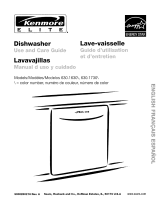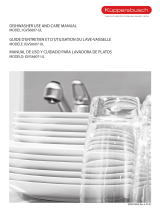
15
resume the cycle, press the On/Off button and shut the dishwasher door.
Canceling or Changing a Cycle
To cancel or c
hange a cycle, open the dishwasher door far enough to expose the control
buttons then press and hold for three seconds the two buttons labeled “Cancel Drain” as
sho
wn in Figure 21.
Close the door and wait until the dishwasher completes the cycle (approximately 1
minut
e). Open the door and press the ON/OFF button.
You may now begin a new cycle.
Child Safety Latch (select models)
Your dishwasher is shipped from the factory with the Child Safety Latch disengaged and
in the normal operating mode. Pull on the door handle to open the door. The Child Safety
latch activation lever is located in the recess for the door handle. You must look up into the
recess to nd the Child Safety Latch activation lever (see Figure 22).
To activ
ate the Child Safety Latch insert a matchstick or other non-metal object into the
opening as shown in Figure 22. The activation lever will release and move toward the left.
You have now activated the Child Safety Latch. Each time you open the dishwasher
door you will need to slide the activation lever to the right to release the door locking
mec
hanism, you can then pull the door open (See Figure 23). After you open the door you
should release the Child Safety Latch Activation lever and let it slide back toward the left.
To deactivate the Child Safety Latch insert a matchstick or other non-metal object into the
opening as shown in Figure 24. Slide the activation lever to the right and hold. Remove the
matchstick and release the lever. The feature has now been deactivated and you can open
the door by pulling the handle.
Child Lock (select models)
T
he Child Lock feature allows you to disable the dishwasher control panel to prevent acci-
dent
al activation. To activate this feature press and hold the button labeled “Child Lock” for
4 seconds and the “Child lock” indicator light will illuminate. To disable the feature, press
and hold the “Child Lock” button for 4 seconds.
Dishware Drying
At t
he end of the cycle the dishwasher will stop and a period of condensation drying will
follow. After drying, the cycle is complete and:
• the “Clean” light will illuminate (select models).
• the completion signal will sound (select models).
• the “Sanitized” light may appear. See section on Sanitization for more information.
• the countdown display will show “0” (select models).
NOTE: I
f your household water supply is too hot, your dishwasher’s heating time may be
reduced and the “Sanitized” light may not illuminate. Your Dishwasher Installation Manual
has information on the recommended temperature for your household hot water supply.
NOTE: To accelerate and enhance drying, open the dishwasher door, pull the top rack a few
inches out of the dishwasher, and prop the dishwasher door against the top rack.
Sanitized Light
When t
he Sanitized light appears, it means that the dishware and kitchenware that was
just washed has been sanitized according to the requirements of the National Sanitation
Foundation (NSF). For more information on NSF certication, refer to the Wash Cycle
Information section of this manual.
Unloading the Dishwasher
Unload the bottom rack rst.
Unload the silverware basket(s). They are easily removed for unloading.
Unload the top rack.
If the Extra Tall Item Sprinkler was installed, return the dishwasher to its normal condition
(see the Loading Extra Tall Items instructions in the “Loading the Dishwasher” section of
this manual).
Figure 22
Figure 23
Figure 24
Figure 21






















